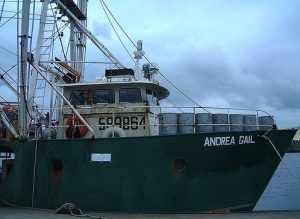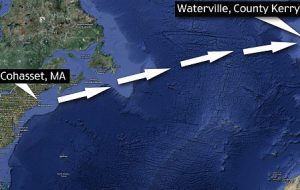Monthly Archives: December 2016

 After the movie, The Perfect Storm came out, swordfishing boat, Andrea Gail became almost a household name. We could relate to the feelings of loss the families of those men felt, and found it hard to get past the idea of how those men died. Those things are a normal reaction to such a tragedy, but in the end, we expected they would find the swordfishing boat, and be able to bring closure to the families…allowing them to bury their dead. Sometimes, however, a lost ship takes a long time to find, and strangely, sometimes it is never found at all. Such was the case with the Andrea Gail. Her last coordinates had been called out on the emergency radio, but this was such a fierce storm, and the Andrea Gail was right in the middle of it, trying desperately to make it back home.
After the movie, The Perfect Storm came out, swordfishing boat, Andrea Gail became almost a household name. We could relate to the feelings of loss the families of those men felt, and found it hard to get past the idea of how those men died. Those things are a normal reaction to such a tragedy, but in the end, we expected they would find the swordfishing boat, and be able to bring closure to the families…allowing them to bury their dead. Sometimes, however, a lost ship takes a long time to find, and strangely, sometimes it is never found at all. Such was the case with the Andrea Gail. Her last coordinates had been called out on the emergency radio, but this was such a fierce storm, and the Andrea Gail was right in the middle of it, trying desperately to make it back home.
The name Perfect Storm depicted not just another storm or even just another hurricane…this storm was a monster. The 1991 Perfect Storm, also known as the The No-Name Storm, especially in the years immediately after it took place, and the Halloween Gale, was a nor’easter that absorbed Hurricane Grace and ultimately evolved back into a small unnamed hurricane late in its life cycle. The area of low pressure developed off Atlantic Canada on October 29. A ridge of high pressure to its north pushed it southward. Then, it reached its peak intensity as a large and powerful cyclone. The storm battered the east coast of the United States with high waves and coastal flooding before it turned southwest and weakened. Moving over warmer waters, it transitioned into a subtropical cyclone before becoming a tropical storm. It made a loop off the Mid-Atlantic states and turned toward the northeast. On November 1 the system evolved into a full-fledged hurricane with peak winds of 75 miles per hour, although the National Hurricane Center left it unnamed to avoid confusion amid media interest in the predecessor extratropical storm. It later received the name “the Perfect Storm” after a conversation between Boston National Weather Service forecaster Robert Case and author Sebastian Junger. The system was the fourth hurricane and final tropical cyclone in the 1991 Atlantic hurricane season. The tropical system weakened, striking Nova Scotia as a tropical storm before dissipating. There were thirteen confirmed deaths from the storm, including six on board Andrea Gail.
Everyone who saw the movie, now also knows about the Flemish Cap, which is an area of the Atlantic Ocean off the coast of Nova Scotia, and was where the Andrea Gail was when The Perfect Storm began its rampage. The Andrea Gail had sailed from Gloucester, Massachusetts on September 20, 1991, and after a minimal catch, sailed for the Flemish Cap. After encountering high seas in the middle of the storm, the vessel made its last radio contact late on October 28 about 180 miles northeast of Sable Island. After that, they tried to make a run for it through the storm, rather than lose their catch to spoil. The Andrea Gail sank while returning to Gloucester. Over the next few days, only three pieces of debris were found, and the Coast Guard said those could have washed off the boat in rough seas. To date, the boat, and her crew, David Sullivan, Robert Shatford, William Tyne, Dale Murphy, Michael Moran, and Alfred Pierre, have never been found.
However…on December 2, 2011 the Daily Mail Reporter printed this story…Lobster pot tag washes up 3,000 miles away across the Atlantic…two decades after being lost in Perfect Storm that inspired film. “A tag from a lobster pot lost two decades ago in what came to be known as ‘The Perfect Storm’ has washed up 3,000 miles away in Ireland. The pot that held the tag with Richard Figueiredo’s name on it was one of hundreds he lost when the storm struck off Cohasset, Massachusetts, in 1991. Rosemary Hill, of Waterville, County Kerry, found the tag on a beach last year. Last week she decided to try to contact Mr Figueiredo and found him through the Facebook account of his son Rich. Oceanographer Curt Ebbesmeyer told The Patriot Ledger newspaper that the tag’s 20-year drift is unusually long. Mr Ebbesmeyer, who studies flotsam and ocean currents, said the pot and tag may have been buried in offshore mud before drifting south off the U.S. Atlantic coast and then getting caught the in eastward Gulf Stream. He added that the tag then probably drifted south again into the circular Subtropical Gyre current in the mid-Atlantic, making six three-year loops before it again caught the Gulf Stream toward Ireland. Coast to coast: The tag would have made several loops as it drifted with a leading oceanographer saying it may have clocked up 50,000 miles. He believes in total it could have drifted 50,000 miles. Miss Hill, 39, loves beachcombing and said that this is the first time she’s ever traced a buoy or other piece of maritime flotsam to its owner. She told The Patriot Ledger she saw the orange tag amid clumps of seaweed on a stroll last year. She added it to other beach souvenirs and then forgot about it until last week. ‘I 
 looked at it again and thought, “Why not try to find the owner?”‘ she said. ‘Nothing ventured, nothing gained.’ Mr Figueiredo and Miss Hill spoke last Thursday. She said she would mail the tag to him, but he wants her to keep it. He said: ‘The meaning it has over there is what matters. ‘I am honored that she has put so much enthusiasm into this. What’s happening now is a gift to me.'” I find that to be an absolutely amazing journey.
looked at it again and thought, “Why not try to find the owner?”‘ she said. ‘Nothing ventured, nothing gained.’ Mr Figueiredo and Miss Hill spoke last Thursday. She said she would mail the tag to him, but he wants her to keep it. He said: ‘The meaning it has over there is what matters. ‘I am honored that she has put so much enthusiasm into this. What’s happening now is a gift to me.'” I find that to be an absolutely amazing journey.
 Anytime a nation’s leader is killed, it’s a disaster, no matter how they died, but it is not so common for the disaster to still be felt when their child is killed, although the nation naturally feels a degree of collective sadness. In a monarchy, however, things are different. The child of the current king stands to be the next leader. These days, having a girl be the next in line for the throne is not a problem, in most nations, but that was not the case in England in 1120. At the time, the king of England was King Henry I. The Norman dynasty had not been in power very long, and the King Henry I was very eager to have the line continue on. His problem was solved with the birth of his only legitimate son, William the Aethling, who was called by the Saxon princely title to stress that his parents had united both Saxon and Norman Royal Houses. William was a warrior prince who, even at the age of seventeen, fought alongside his father to reassert their rights in their Norman lands on the Continent. As was common with kings, especially in that era, and maybe not so unusual in this era, the king had multiple concubines, and so several illegitimate children too. He did have a legitimate daughter named Matilda, but the throne belonged to his son. His illegitimate children were Richard, and oddly, a second Matilda. All seemed right in his world.
Anytime a nation’s leader is killed, it’s a disaster, no matter how they died, but it is not so common for the disaster to still be felt when their child is killed, although the nation naturally feels a degree of collective sadness. In a monarchy, however, things are different. The child of the current king stands to be the next leader. These days, having a girl be the next in line for the throne is not a problem, in most nations, but that was not the case in England in 1120. At the time, the king of England was King Henry I. The Norman dynasty had not been in power very long, and the King Henry I was very eager to have the line continue on. His problem was solved with the birth of his only legitimate son, William the Aethling, who was called by the Saxon princely title to stress that his parents had united both Saxon and Norman Royal Houses. William was a warrior prince who, even at the age of seventeen, fought alongside his father to reassert their rights in their Norman lands on the Continent. As was common with kings, especially in that era, and maybe not so unusual in this era, the king had multiple concubines, and so several illegitimate children too. He did have a legitimate daughter named Matilda, but the throne belonged to his son. His illegitimate children were Richard, and oddly, a second Matilda. All seemed right in his world.
King Henry I was king from August 2, 1100, until his death on December 1, 1135, and expected that his son, Prince William would take his place as king upon his death. Then disaster struck on the November 25, 1120. This was a disaster that would have a dramatic effect, not only on the families of those involved, but on the very fabric of English Government. After a successful battle in 1119, which brought the defeat of King Louis IV of France, and the humiliation at the Battle of Brémule, the King and his entourage were headed home to celebrate. The king was offered a fine ship, the White Ship to travel home in, but he declined because he had already made other arrangements. He suggested that his son and some of the other men could talk the journey on the White Ship.
As the heir to the throne, Prince William attracted the cream of society to surround him. His entourage was to include some three hundred fellow passengers…140 knights and 18 noblewomen, his half-brother, Richard, his half-sister, Matilda the Countess of Perche; his cousins, Stephen and Matilda of Blois, the nephew of the German Emperor Henry V, the young Earl of Chester and most of the heirs to the great estates of England and Normandy. The passengers were all in a mood to celebrate, and asked the Prince for drinks. The prince had brought wine aboard the ship by the barrel-load to help with the festivities. Before long the both passengers and crew became highly intoxicated. Some even left the shop when things started getting abusive.
The people who remained were drunk, and decided that it would be a great idea to try to catch the ship the king was on. The king’s ship had already sailed out into the English Channel.  The people kept pushing the captain to accept the challenge. The captain was sure that his ship could catch the king’s ship, so they set out that evening, and immediately struck a rock in the channel as they left. The ship began to sink, and Prince William was safely in a boat, but he heard his half-sister, Matilda screaming for help. So he left the boat to rescue her. The boat he was in was hit by a group of desparate passengers, and swamped. Prince William was lost and drown. The nation was devastated, and when King Henry I tried to get them to accept his legitimate daughter, Matilda, but they didn’t want to and when the king died, Matilda and her husband found themselves fighting for the throne in a war known as The Anarchy.
The people kept pushing the captain to accept the challenge. The captain was sure that his ship could catch the king’s ship, so they set out that evening, and immediately struck a rock in the channel as they left. The ship began to sink, and Prince William was safely in a boat, but he heard his half-sister, Matilda screaming for help. So he left the boat to rescue her. The boat he was in was hit by a group of desparate passengers, and swamped. Prince William was lost and drown. The nation was devastated, and when King Henry I tried to get them to accept his legitimate daughter, Matilda, but they didn’t want to and when the king died, Matilda and her husband found themselves fighting for the throne in a war known as The Anarchy.

